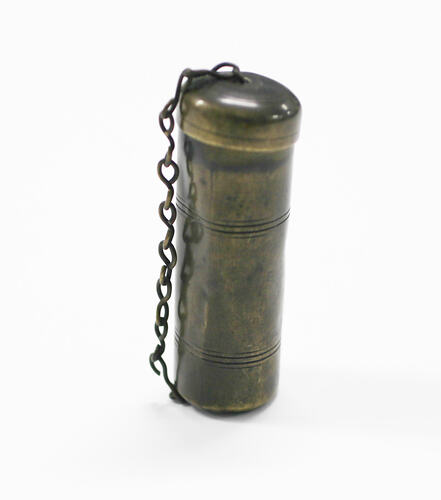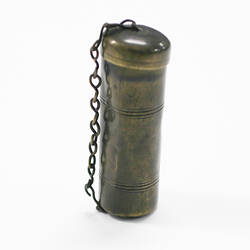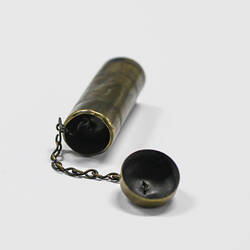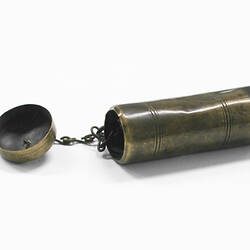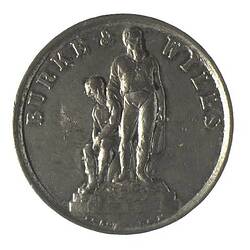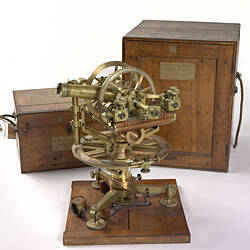Summary
Brass tinder box with note 'Tinder Box used by Burke & Wills, / found by E.C. King / in Sturt's Stony Ranges'. The donor explains: 'This was found amongst my great aunt's possessions when she died in 1998. She was in her early 90's at the time and had lived in Menindee her whole life. She owned the Albemarle hotel until 1967. Her family was also in the area before that and at one point I think owned Maiden's hotel. How this came into her possession I have no idea. Her name was Aileen Underdown. Late in life she married and became Aileen Morphett.'
Research by Museums Victoria has identified the likely person referred to in the tinder box note: Euston Corynder King (1864-1949), who was a mining district warden in the Sturt Stony Ranges area, north of Menindie where the donor's great aunt Aileen Underdown lived. E.C. King later married a Menindie woman, confirming the local link. Research has found a record of E.C. King and Aileen's father Lycurgus Edward (Ted) Underdown (1870-1921) actually leasing consecutive properties in the same area on the same date - 27 Jan 1910. Research has also confirmed that the Underdowns did operate pubs including the Maidens Hotel (aka Paine's pub; aka Menindee Hotel) where the Burke & Wills expedition stayed.
The Burke & Wills expedition did go through the Sturt (Sturt's) Stony Ranges (Desert), in the far north-west of NSW, and it is not inconceivable they were casting off or loosing things in that vicinity. E.C. King was a mining warden in the 1880s and may have retrieved the tinder box then, making the reasonable assumption it was from the Burke & Wills expedition. However, the specific reason for his assumption is unknown. (The desert was named by another explorer, Charles Sturt, who had traversed the area in 1844 looking for an inland sea.) Search parties also passed through the area after the loss of Burke & Wills, and many First Peoples lived in the area. Further research is required to determine other expeditions that took approximate route in the 1860s-80s, to whom the tinder box might alternatively have belonged.
Interestingly, the Burke & Wills expedition's List of Stores. Part III, includes 28 'Tinder boxes with flint and steel', which cost 12/ each. The Burke & Wills expedition was apparently supplied by Government Storekeeper Richard Nash.
The style of the tinder box is appropriate for the 1860s period. Museums Victoria holds a very similar example - ST 012856 - without provenance, acquired for the collection in 1921. MAAS also hold similar tinder boxes, undated: H7734, H7735 and H7736, each with a small flint and steel striker, indicating the sort of contents HT 57380 may have held. Similar flints are held in Museums Victoria's archaeological collection: LL 9157 and LL 9156 (size to be confirmed).
Physical Description
Small brass cylindrical tinder box with lid. Lid attached to body by chain attached to centre top of lid and centre bottom of body. Two sets of four concentric grooves on body - the centre two of each pair is heavier, and the other two lighter. The lid, wider in circumferance than the body, has one heavy and one light concentric groove. Body is significantly dented on all sides. The base can be pushed into the body, allowing easy access to the contents. The tinder box contains a small hand-written note on browned paper, with remnants of adhesive tape across the top, which has caused deterioration and losses to the paper.
More Information
-
Collecting Areas
-
Date Made
-
Collector
Euston C. King, Sturt Stony Desert, New South Wales, Australia, 1880-1889
-
Previous Owner
-
User (Possible)
-
User (Possible)
-
Inscriptions
Hand-written on note: 'Tinder Box / used by Bourke & Wills, / found by E.C. King / in Sturt's Stony Ranges'.
-
Classification
-
Category
-
Discipline
-
Type of item
-
References
State Library of Victoria, SLV MS13071, Box 2088B/2. Financial Records of the Royal Society of Victoria's Exploration Committee, Royal Society of Victoria Exploration Committee account book 1858-1873. 1 bound volume, manuscript, pages numbered 1 to 162. pp. 1-13. List of articles and services...supplied.by [Richard Nash] the Government Storekeeper. Accessed via [Link 1] 22/11/2022.
-
Keywords
